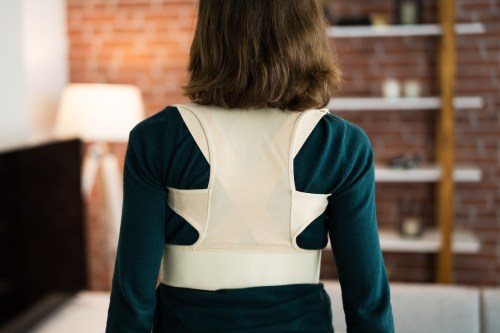Our editors independently select these products. Making a purchase through our links may earn Well+Good a commission
Between spending long hours on a computer, too much time spent hunched over my phone, and a tendency to schlep around New York City with a bag overloaded with stuff, my posture could stand to be corrected. Sure, I manage to fit in some spinal stretches and workouts a few days a week, but is that enough when the time I spend doing those posture-friendly activities is a tiny fraction of my day compared to all the typing/scrolling? Recently, I’ve been wondering if I should start using a posture corrector during the day while I’m at my desk.
Experts in This Article
board-certified orthopaedic physical therapist, certified early intervention specialist, and owner of Marko Physical Therapy
I’ve noticed them everywhere from Amazon to Instagram. As a skeptical, yet curious, health writer, I decided to find out more about these trendy devices and whether they could really help train me to sit up straighter. So I spoke to a physical therapist Theresa Marko, DPT, founder of Marko Physical Therapy to find out if posture correctors work, or if they’re a waste of time and money.
What is a posture corrector?
There are a ton of different types of posture correctors out there, but most of them work generally the same. The idea is that you strap one on—they kind of look like soft-shell back braces or harnesses—and just by wearing it, you’ll sit up straighter, which keeps you from wrecking your posture (simple, right?).
“They can help as a physical block to slouch, but also just wearing something on you will make you remember to sit upright more,” says Dr. Marko who likes the Comfy Brace Posture Corrector ($16) since it’s worked for some of her patients. “This one helps to keep your shoulders back and your shoulder blades more together,” she says. “It also helps to remind you to sit upright when you want to slouch forward. Sitting upright involves an erect spine and shoulder blades sitting close together.”
Because of their simple design and lower price points, braces are popular posture correctors, but there’s also posture straps like the Back Embrace ($60), and tech-enabled posture devices, like the Upright Go ($60 and $80) that buzzes to alert you when you’re slumping or rounding your spine. Instead of forcing your posture in a certain position, these are more like helpful reminders that “train” you to sit straight or stop hunching throughout the day.
No matter which option you choose, it’s important to keep in mind that a posture corrector should only be a temporary fix. “Ultimately, you don’t want to wear a brace long-term,” says dr. Marko. “You want to get stronger so that you have the stability to hold yourself up.” She recommends limiting wearing posture correctors to a few hours a day, and for no more than a month or so.
One sign that you may need to work on strengthening those postural muscles (the stabilizers that support your spine in your deep core and upper back) is that you slouch in the first place. “Many people have a hard time sitting upright because of decreased strength,” says Dr. Marko. To work on your posture, Dr. Marko recommends strengthening the shoulders and back with the exercises below.
3 exercises to help strengthen your postural muscles
1. Prone I, Y, T
How to do it: Start by lying on the floor on your stomach with arms extended by sides, palms facing down and resting on the floor. Either lift up your head, neck, and chest slightly off the ground so that you’re gaze is fixed a few inches in front of your nose or rest your forehead on the floor on a rolled up towel, whichever you prefer.
To do the “I”: Squeeze your shoulder blades together and lift your arms a few inches into the air. Hold for a breath, then return to start position. Repeat two sets of 10.
To do the “T”: Now, extend both arms straight out at shoulder height, palms down so that you are in a “T” shape on the floor. Squeeze shoulder blades together and lift arms up a few inches into the air. Hold for a breath, then return to start position. Repeat two sets of 10.
To do the “Y”: Place both arms overhead at 45-degree angles so your body forms a “Y” shape on the floor—for this one, palms can be face down or you can rotate your hands so your thumbs face the ceiling. Lift arms up a few inches into the air. Hold for a breath, then return to start position. Repeat two sets of 10.
2. Resistance Band Row
How to do it: Take a resistance band and tie a knot in the middle of the band. Close the knot into a door by shutting the door with the knot on the other side of the door. Place the band at elbow height in the door. Be sure to be standing on the side of the door that does NOT open toward you so that you’re not pulling the door to open every time you pull on the band.
Hold the band by both hands and pull it back toward your chest, squeezing your shoulder blades together so that your elbows end up in a 90 degree angles at your sides. Slowly release the band straight. Repeat for two sets of 10.
Alternate move: No door? No Problem. You can also hold the resistance band taut at chest height with both arms out in front of you in line with shoulders, and pull your arms apart so that the band stretches across your chest. “These are easy exercises to strengthen your shoulder blades and upper back,” Dr. Marko says.
3. Resistance Band Horizontal Abduction
How to do it: Stand upright with a slack resistance band at chest height, arms straight with elbows extended but not locked out. Pull the band open across your chest by opening your arms into a “T” position. Slowly return the band back to the start position. Repeat two sets of 10.
Note: “For this move, you control how much resistance you have,” says Dr. Marko. “If you hold the band tighter, it will be harder, if you hold the band looser, it will be easier. Be sure not to make it too difficult or your neck muscles will engage.” So if you feel tension in your traps (those muscles that run from down the sides of your neck to your shoulders, give yourself some slack.
Sign Up for Our Daily Newsletter
Get all the latest in wellness, trends, food, fitness, beauty, and more delivered right to your inbox.
Got it, you've been added to our email list.











